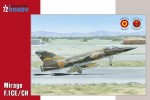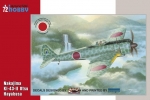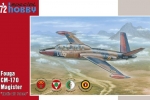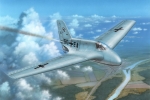1⁄72
Tuesday, January 19, 2016 - 02:23 AM UTC
Special Hobby have announced three new 1:72 kits this month. WW2 enthusiasts can look forward to a Ki-43 Oscar and the Mirage F.1 and Magister should keep fans of classic jets busy for a while. Meanwhile, there's an Me 163A on the horizon.
SH72289 - Mirage F.1CE/CH 1/72
The Mirage F.1C came to being as a private venture of the French Dassault company. The French Air Force, or the Armée de l´Air, had ordered two prototype aircraft named Mirage F.2 and Mirage F.3 which were to be equipped with a JTF10 engine. However, Dassault built on their own expenses yet another prototype, smaller than the two previous and fitted with an Atar 9K power plant. This machine, which was eventually chosen, took off for its maiden flight on 23 December 1966 and production aircraft were put on strenght of the Armée de l´Air in single-seater fighter version known as the F.1C and two-seater F.1B trainer version. During their service, a number of the machines was upgraded by fitting of IFR probes which gave the F-1C-200 version. The French Air Force used also a dedicated reconnaissance and a ground-attack version, designated the F.1CR and CT respectivelly, the latter being converted from F.1-200 machines. In total, 246 of all versions served with the French, the type was exported abroad and enjoyed success with foreign air forces. In Europe, the Greeks and the Spanish flew the Mirage F.1C, in South America there was only a sole operator, the Fuerza Aerea Ecuatoriana, but in Africa and Asia the Mirage F.1C an B were put on strenght of air forces of Gabon, South Africa, Morocco, Libya, Iran, Iraq, Jordan, Qatar and Kuwait and were used in many clashes around the world, including no-shot combats of Greek pilots against their Turkish adversaries, as well as French military actions in Chad, Ecuadorian over-border skirmishes with Peru, battles of South African Mirages against Angola-based Cuban fighters and the list might end with mentioning the Iran-Iraq war in which the Mirages were used by either side. And even nowadays the type keeps on flying in several countries.
The parts for the detailed Mirage model kit come in six separate frames, it further contains one frame of clear parts and resin detail parts showing the different Mirage F.1 versions for Spain and Morocco – these have different launcher racks and flare dispensers.
The decals (made by Cartograf) offer three Spanish planes, each with a different camouflage and two Moroccan planes.
SH72193 - Nakajima Ki-43-II Otsu 1/72
The Imperial Japanese Air Force issued Nakajima Company, without the usual competition, in December 1937 with the development of a new fighter aircraft. This new fighter was supposed to replace the recently assigned Ki-27. The development was complicated and somewhat prolonged because of the modifications. Thirteen prototypes were built and subsequently the new fighter, designated Ki-43-I Ko with the combat name Hayabusa, was accepted by the IJAF on January 1, 1941, though the series production had started in September 1940. The prototype of the new version Ki-43-II with a more powerful Ha-115 engine, shortened and strengthened wing took off for the first time in February 1942. Soon this new version replaced the older in production lines. The part of the production was shifted to other companies. The development continued from Ki-43-II Otsu to Ki-43-III. The different versions sported different shapes of cowlings, oil coolers and subsequently the armament was changed to heavier. Hayabusa soon became the most widely used fighter by IJAF. It fought from the beginning of the war up to its bitter end. Hayabusas were assigned to forty regular Sentais and twelve independent Hiko Sentais. Except of the latter, Hayabusas were used by the puppet state Manchukuo, Thailand and after the war by Indonesia, communist China and French Colonial Forces in Indo-China. Hayabusa was considered highly a dangerous opponent at the beginning of the war. This suspicion was confirmed when a seized example of Ki-43 was tested. Allied pilots were then warned not to try to dogfight Hayabusas and instead use hit and run tactics. In the mainland CBI area allied intelligence issued for Ki-43 recognition code name Jim. In South East Pacific area it was named Oscar and this name was officially accepted for Nakajima Ki-43 of all versions.
The Ki-43-II Otsu version model kit comes in four frames of plastic parts, one frame of clear parts, an instruction sheet in colour and with high-quality decals made by the Italian Cartograf. You can choose between four very interesting camouflages.
SH72284 - Fouga Magister "Exotic Air Forces" 1/72
The successful French Fouga CM.170 Magister lightweight jet trainer found its origins in a powered glider design of all-metal construction called the C.M.8.15 which sported a butterfly style tail empennage and was designed by P.Mauboussin and J.Szydlowski. This turbojet-powered glider flew for the first time in 1949 and during development of this design a number of test machines emerged including a unique twin-fuselage aircraft designated as the Gemeaux. The final stage of development of the C.M.8.15 glider led to the CM.170 Magister which was designed to meet an Armée de l´Air specification and like the powered gliders which preceded it this also sported a distinctive butterfly-type empennage.
An initial order for three prototype Magisters was made, the first of which made its maiden flight on 23 July, 1952 and as the performance was found to be acceptable this led to a follow on order for a batch of ten pre production aircraft. As per usual most of the prototype and pre production aircraft were used for testing of various components and improvements which would later be incorporated into full production airframes, the only exception to this was the second prototype which at the request of the military was modified to accept a standard fin and tailplanes. However as the flying characteristics in this configuration were found to be no better, all subsequent machines continued to feature the trademark butterfly tail. As well as serving with the French military the Magister was also an export success for Fouga which sold the type to a multitude of foreign operators and it was even built under licence in three countries. The first licence-built Magisters entered service with the air forces of Germany and Finland in 1958 where they also joined French-built Magisters and the third licence producer of the Magister was Israel, which produced its first aircraft in 1960. The Israeli Magisters were known locally as the Tzukit (or Thrush) and as well as basic training they were also used in the light-attack role where they proved successful during several of the Israeli-Arab conflicts. In the ground attack role the Magister could carry a pair of machine guns fitted in the nose section and various weaponry was mounted under the wings in the form of bombs and unguided rockets.
Within Europe the Magister was flown by France, Belgium, Austria and Ireland but there were also many other operators worldwide in Africa, Asia and South America, many of whom were no doubt attracted by its lightweight design and low operating costs. Among these far flung operators were countries such as Algeria, Bangladesh, Biafra, Brazil, El Salvador, Libya, Morocco, Togo and Uganda. Some Fougas are still flying these days, many of them in civilian hands.
Besides the standard trainer and light attack versions there was also a navalized variant of the Magister known as the Fouga CM.175 Zéphyr which was operated solely by the French Navy to carry out deck landing training for its trainee fast jet pilots. This airframe was stronger to cope with the rigours of deck operations and the main external differences were a set of strengthened undercarriage legs, a different nose section incorporating rear-sliding canopy hoods which could be opened in flight to aid swift exit in case of emergency during take off and landing at sea and of course it was also equipped with an arrester hook. Further variants of the basic Magister design concept were also proposed but most remained on the drawing board as paper projects or did not proceed past the prototype stages.
WE ARE PREPARING: SH72334 Messerschmitt Me 163A 1/72
Please remember, when contacting retailers or manufacturers, to mention that you saw their products highlighted here - on AEROSCALE.
The Mirage F.1C came to being as a private venture of the French Dassault company. The French Air Force, or the Armée de l´Air, had ordered two prototype aircraft named Mirage F.2 and Mirage F.3 which were to be equipped with a JTF10 engine. However, Dassault built on their own expenses yet another prototype, smaller than the two previous and fitted with an Atar 9K power plant. This machine, which was eventually chosen, took off for its maiden flight on 23 December 1966 and production aircraft were put on strenght of the Armée de l´Air in single-seater fighter version known as the F.1C and two-seater F.1B trainer version. During their service, a number of the machines was upgraded by fitting of IFR probes which gave the F-1C-200 version. The French Air Force used also a dedicated reconnaissance and a ground-attack version, designated the F.1CR and CT respectivelly, the latter being converted from F.1-200 machines. In total, 246 of all versions served with the French, the type was exported abroad and enjoyed success with foreign air forces. In Europe, the Greeks and the Spanish flew the Mirage F.1C, in South America there was only a sole operator, the Fuerza Aerea Ecuatoriana, but in Africa and Asia the Mirage F.1C an B were put on strenght of air forces of Gabon, South Africa, Morocco, Libya, Iran, Iraq, Jordan, Qatar and Kuwait and were used in many clashes around the world, including no-shot combats of Greek pilots against their Turkish adversaries, as well as French military actions in Chad, Ecuadorian over-border skirmishes with Peru, battles of South African Mirages against Angola-based Cuban fighters and the list might end with mentioning the Iran-Iraq war in which the Mirages were used by either side. And even nowadays the type keeps on flying in several countries.
The parts for the detailed Mirage model kit come in six separate frames, it further contains one frame of clear parts and resin detail parts showing the different Mirage F.1 versions for Spain and Morocco – these have different launcher racks and flare dispensers.
The decals (made by Cartograf) offer three Spanish planes, each with a different camouflage and two Moroccan planes.
SH72193 - Nakajima Ki-43-II Otsu 1/72
The Imperial Japanese Air Force issued Nakajima Company, without the usual competition, in December 1937 with the development of a new fighter aircraft. This new fighter was supposed to replace the recently assigned Ki-27. The development was complicated and somewhat prolonged because of the modifications. Thirteen prototypes were built and subsequently the new fighter, designated Ki-43-I Ko with the combat name Hayabusa, was accepted by the IJAF on January 1, 1941, though the series production had started in September 1940. The prototype of the new version Ki-43-II with a more powerful Ha-115 engine, shortened and strengthened wing took off for the first time in February 1942. Soon this new version replaced the older in production lines. The part of the production was shifted to other companies. The development continued from Ki-43-II Otsu to Ki-43-III. The different versions sported different shapes of cowlings, oil coolers and subsequently the armament was changed to heavier. Hayabusa soon became the most widely used fighter by IJAF. It fought from the beginning of the war up to its bitter end. Hayabusas were assigned to forty regular Sentais and twelve independent Hiko Sentais. Except of the latter, Hayabusas were used by the puppet state Manchukuo, Thailand and after the war by Indonesia, communist China and French Colonial Forces in Indo-China. Hayabusa was considered highly a dangerous opponent at the beginning of the war. This suspicion was confirmed when a seized example of Ki-43 was tested. Allied pilots were then warned not to try to dogfight Hayabusas and instead use hit and run tactics. In the mainland CBI area allied intelligence issued for Ki-43 recognition code name Jim. In South East Pacific area it was named Oscar and this name was officially accepted for Nakajima Ki-43 of all versions.
The Ki-43-II Otsu version model kit comes in four frames of plastic parts, one frame of clear parts, an instruction sheet in colour and with high-quality decals made by the Italian Cartograf. You can choose between four very interesting camouflages.
SH72284 - Fouga Magister "Exotic Air Forces" 1/72
The successful French Fouga CM.170 Magister lightweight jet trainer found its origins in a powered glider design of all-metal construction called the C.M.8.15 which sported a butterfly style tail empennage and was designed by P.Mauboussin and J.Szydlowski. This turbojet-powered glider flew for the first time in 1949 and during development of this design a number of test machines emerged including a unique twin-fuselage aircraft designated as the Gemeaux. The final stage of development of the C.M.8.15 glider led to the CM.170 Magister which was designed to meet an Armée de l´Air specification and like the powered gliders which preceded it this also sported a distinctive butterfly-type empennage.
An initial order for three prototype Magisters was made, the first of which made its maiden flight on 23 July, 1952 and as the performance was found to be acceptable this led to a follow on order for a batch of ten pre production aircraft. As per usual most of the prototype and pre production aircraft were used for testing of various components and improvements which would later be incorporated into full production airframes, the only exception to this was the second prototype which at the request of the military was modified to accept a standard fin and tailplanes. However as the flying characteristics in this configuration were found to be no better, all subsequent machines continued to feature the trademark butterfly tail. As well as serving with the French military the Magister was also an export success for Fouga which sold the type to a multitude of foreign operators and it was even built under licence in three countries. The first licence-built Magisters entered service with the air forces of Germany and Finland in 1958 where they also joined French-built Magisters and the third licence producer of the Magister was Israel, which produced its first aircraft in 1960. The Israeli Magisters were known locally as the Tzukit (or Thrush) and as well as basic training they were also used in the light-attack role where they proved successful during several of the Israeli-Arab conflicts. In the ground attack role the Magister could carry a pair of machine guns fitted in the nose section and various weaponry was mounted under the wings in the form of bombs and unguided rockets.
Within Europe the Magister was flown by France, Belgium, Austria and Ireland but there were also many other operators worldwide in Africa, Asia and South America, many of whom were no doubt attracted by its lightweight design and low operating costs. Among these far flung operators were countries such as Algeria, Bangladesh, Biafra, Brazil, El Salvador, Libya, Morocco, Togo and Uganda. Some Fougas are still flying these days, many of them in civilian hands.
Besides the standard trainer and light attack versions there was also a navalized variant of the Magister known as the Fouga CM.175 Zéphyr which was operated solely by the French Navy to carry out deck landing training for its trainee fast jet pilots. This airframe was stronger to cope with the rigours of deck operations and the main external differences were a set of strengthened undercarriage legs, a different nose section incorporating rear-sliding canopy hoods which could be opened in flight to aid swift exit in case of emergency during take off and landing at sea and of course it was also equipped with an arrester hook. Further variants of the basic Magister design concept were also proposed but most remained on the drawing board as paper projects or did not proceed past the prototype stages.
WE ARE PREPARING: SH72334 Messerschmitt Me 163A 1/72
Please remember, when contacting retailers or manufacturers, to mention that you saw their products highlighted here - on AEROSCALE.
Click Star to Rate
Only 1 reader has rated this.
THIS STORY HAS BEEN READ 4,882 TIMES.
| Special Hobby Reviews | MORE |
| Sunderland Mk.III by Tim Hatton | of 1 ratings, 100% found this helpful | |
| AH-1G Cobra by Andy Brazier | of 1 ratings, 100% found this helpful | |
| Reggiane Re.2005 Sagittario by Rowan Baylis | |
| Hawker Tempest Mk.VI by Tim Hatton | of 1 ratings, 100% found this helpful | |
| Mirage F.1EQ/ED by Tim Hatton | |
| DH 100 Vampire Mk.I by Tim Hatton | |
| FH-1 Phantom by Andy Brazier | of 1 ratings, 100% found this helpful | |
| Saab SK-37E Viggen by Rowan Baylis | |
| Dornier Do 27/CASA C-127 by Tim Hatton | |
| Barracuda Mk.II by Andy Brazier | |
| Blackburn Skua Mk. II by Rowan Baylis | of 2 ratings, 100% found this helpful | |
| Fokker D.II by Rowan Baylis | of 1 ratings, 100% found this helpful | |
| SB2C-5 Helldiver by Andy Brazier | |
| Yak-3 by Rowan Baylis | of 2 ratings, 100% found this helpful | |
| CA-19 Wirraway by Is a secret | |












Comments